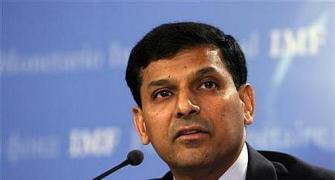True sustainable growth can come only through an increase in productivity, and such increases can happen only through innovations, technical and organisational, in all sectors of the economy - industry, services and agriculture, writes Ajit Balakrishnan.
Newspaper headlines such as “India GDP growth falls to 4.5 per cent” or “S&P downgrades India’s GDP growth”, which frequently greet the Indian newspaper reader and cause palpitations in many an Indian heart, have become a feature of modern life in the country. The unstated assumption in all this is that pursuing a high GDP growth rate ought to be the single-minded goal of any government.
 With so much talk about GDP, it is easy to forget that the concept of GDP - and its use as a measure of a nation’s strength and well-being - is a recent phenomenon. Earlier, a nation’s might was measured in terms of the land area that it controlled - countries such as Britain, which were troubled but owned vast colonies, were looked up to with respect. Then came Simon Kuznets, who was born to a family of Jewish bankers and furriers in Pinsk (formerly in Russia, now in Belarus) and grew up in what is now Ukraine before immigrating to the United States.
With so much talk about GDP, it is easy to forget that the concept of GDP - and its use as a measure of a nation’s strength and well-being - is a recent phenomenon. Earlier, a nation’s might was measured in terms of the land area that it controlled - countries such as Britain, which were troubled but owned vast colonies, were looked up to with respect. Then came Simon Kuznets, who was born to a family of Jewish bankers and furriers in Pinsk (formerly in Russia, now in Belarus) and grew up in what is now Ukraine before immigrating to the United States.
In the 1930s, Kuznets devised for the US a system of accounting that measured at the national level income from all sources. (For a fascinating account of how Kuznets came up with this idea: “Simon Kuznets, Cautious Empiricist of the Eastern European Jewish Diaspora” at http://dx.doi.org/10.2139/ssrn.1324422.) His measure, gross domestic product (GDP), spread globally when the World Bank and the International Monetary Fund (IMF) adopted it to decide which development projects merited funding.
However, what is often forgotten is that it equally matters how high GDP growth is attained. For instance, the Soviet Union grew its GDP 5.4 per cent each year in the period 1928-37 and became a hero in the eyes of many developing countries’ leaders, including Jawaharlal Nehru. It was only many years later that the truth about how the Soviets accomplished this growth became known. The Soviets used force to make farmers give up their own farms, join collective farms and sell their produce to the Soviet government at low prices. That produce was then resold by the government to urban consumers for a profit, which was then used to invest in industries. This created high GDP growth all right, but also doomed Soviet agriculture to mediocre performance for the next half-century. A country that was once the world’s second-largest agricultural producer and exporter could no longer feed itself.
Then there is the case of the other GDP growth “miracle”, this time in East Asia. During a 30-year period starting from 1966, Hong Kong, Indonesia, Japan, South Korea, Singapore, Taiwan and Thailand grew their GDP at an astonishing seven per cent per annum. The World Bank immediately trumpeted this as a vindication of its long-standing advice to countries to pursue an export-led policy. But then, the “East Asian miracle” stopped dead in its tracks in 1997 in what came to be called the “East Asian crisis”.
The crisis, which started in Thailand with the collapse of the Thai baht and rapidly spread to other East Asian countries, saw these countries’ currencies slump, stock markets and real estate prices crash, companies go bankrupt, and their seven per cent growth rate dive to zero. The IMF had to step in and infuse $40 billion to avoid a catastrophe.
New theories quickly sprung up to explain the debacle - “crony capitalism” and “corruption” were two of the more popular explanations - till economist Paul Krugman pointed out the real reason: the “East Asian miracle” had been driven by a vast inflow of international capital (what we in India call foreign institutional investor, or FII, funds). This influx of capital combined with the deployment of plentifully available local labour to create super-duper GDP growth rates.
On the other hand, there had been almost no growth in output per worker, or productivity. The problem with this growth-without-productivity miracle was that once the international investment climate changed and the gush of international capital dried up, GDP growth stopped.
True sustainable growth can come only through an increase in productivity - in other words, when the output of each worker in the economy increases. Such productivity increases can happen only through innovations, technical and organisational, in all sectors of the economy - industry, services and agriculture.
The current Indian discourse is also about attracting vast amounts of FII capital, which, when invested domestically, is expected to make India’s GDP growth rates - and the Sensex - soar. This must be making Kuznets turn in his grave; although he was the inventor of the GDP measure, Kuznets was not overly enthusiastic about using GDP to assess overall national well-being. He felt that the GDP measure did not distinguish between quantity and quality of growth.
For example, the goal of increasing GDP might encourage cutting down forests for lumber, since cutting a forest does more to increase GDP than leaving the forest uncut. But leaving it uncut may have benefits for the ecosystem such as improving water quality in lakes and rivers and generating oxygen. None of these benefits, however, are counted in GDP computations. Some economists say it was the attempt in the US to boost GDP growth in the early 2000s by making it easy to speculate on housing real estate that eventually brought on the world financial crisis.
The only reliable way to drive GDP growth is to improve productivity in the economy. So is it time we devoted time in our newspapers and TV talk shows to discussions about the ways to induce technical and organisational innovations in Indian manufacturing, services and agriculture, and thus improve productivity. Such an approach will, in turn, drive up GDP growth.
Ajit Balakrishnan is the author of The Wave Rider.
ajitb@rediffmail.com









